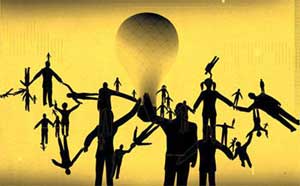Whether you realize it or not, the ideas below have quietly transformed the way we work, live, create, and entertain ourselves. This is BusinessWeek’s selection of the best ideas of 2005.
1. Geography: An Age-Old Tale
 In the workplace, geography is no longer a barrier. Even in a small company, employees can collaborate across continents, as long as they share a common wireless standard for laptops, email addresses, mobile phones, and access to the intranet. Whether you’re in Singapore or California, who really cares?
In the workplace, geography is no longer a barrier. Even in a small company, employees can collaborate across continents, as long as they share a common wireless standard for laptops, email addresses, mobile phones, and access to the intranet. Whether you’re in Singapore or California, who really cares?
On the other hand, two people living in the same apartment can still work in completely opposite time zones. At 7 AM, one might be leisurely finishing a tiring workday with a martini, while the other is rushing to grab a bite before starting their day. Two people halfway across the globe can still be colleagues.
There’s just one thing to keep in mind: Adjust your biological clock accordingly.
2. Simplicity is Golden
 Why press five buttons when you can accomplish the same task with just one? Simplicity is the mantra and the latest trend in design and business management today. As life becomes increasingly hectic and people rush about, everyone needs devices that work faster and more efficiently. After all, who has time to fiddle with manual controls anymore?
Why press five buttons when you can accomplish the same task with just one? Simplicity is the mantra and the latest trend in design and business management today. As life becomes increasingly hectic and people rush about, everyone needs devices that work faster and more efficiently. After all, who has time to fiddle with manual controls anymore?
This is why the iPod Nano became a huge success. The one-button Jura Capresso espresso machine is another example of absolute simplicity. Complexity has become a hindrance for products. The new trend is to strip away the unnecessary, returning products to their most fundamental essence. In 2005 and the years to come, remember: the less complicated, the more profitable.
3. Innovate or Die
 The Knowledge Economy has paved the way for a new economy named Innovation. Information has become a commodity, just like coal or corn. Once, America deluded itself into thinking that Asia could only handle “manual” tasks while design and invention were the exclusive domain of its experts. But it turns out that even “intellectual” work, such as software writing, auditing, and engineering, can be outsourced to India, China, and Eastern Europe just as easily.
The Knowledge Economy has paved the way for a new economy named Innovation. Information has become a commodity, just like coal or corn. Once, America deluded itself into thinking that Asia could only handle “manual” tasks while design and invention were the exclusive domain of its experts. But it turns out that even “intellectual” work, such as software writing, auditing, and engineering, can be outsourced to India, China, and Eastern Europe just as easily.
In this context, the only way to survive is to focus entirely on innovation and design. Regular brainstorming sessions should generate products/services that meet needs consumers themselves might not even realize they have. This is the path to attracting loyal customers, achieving success, and ultimately, survival.
4. Google Wants to Rock with You
 Google will continue to shake up the business world with revolutionary ideas and innovations. The search giant rolls through all fronts like a tank, and invariably, other businesses are the ones who should be worried. From advertising to digitizing books, from search to VoIP, there’s nothing Google doesn’t touch.
Google will continue to shake up the business world with revolutionary ideas and innovations. The search giant rolls through all fronts like a tank, and invariably, other businesses are the ones who should be worried. From advertising to digitizing books, from search to VoIP, there’s nothing Google doesn’t touch.
Continuous innovation is the key to Google’s success. Ideas spring up everywhere, from intense meetings to coffee breaks. Engineers can choose projects they are passionate about. Google’s leadership believes in the “Fail Fast” strategy, accepting numerous failures to seek out “blockbuster” successes. Some of their new services include:
1. Satellite Maps: Allows zooming in on images of areas in Google’s database.
2. Google Base: A classifieds service from Google, allowing users to upload photos and information. Others can access it via search.
3. Local Maps: Standard search results that notify the locations of theaters or restaurants on a specific area map.
4. Gmail: Google’s free email service: large capacity, minimalist interface.
5. Google Print: Digitizing millions of books from the largest libraries in the UK, allowing users to access content for free.
5. The Power and Potential of Open Source
 Once upon a time in companies, all decisions were made in the executive meeting room. Today, in an open workplace environment, power is distributed evenly. CEOs no longer hold absolute power, and capable employees do not want to be puppets on strings pulled by others.
Once upon a time in companies, all decisions were made in the executive meeting room. Today, in an open workplace environment, power is distributed evenly. CEOs no longer hold absolute power, and capable employees do not want to be puppets on strings pulled by others.
New technologies like blogs and internal forums are dismantling the outdated “command and control” structure. Any employee can now propose, edit, refine, or comment on an idea within the company. What was once thought to disrupt the organization has actually enhanced productivity. The workplace becomes brighter when power and information are shared directly, quickly, and openly.
Companies even reach out to the outside world for ideas. Online fan clubs help Lego design new toy sets, allowing their products to sell like hotcakes without spending a dime on marketing. Officials at P&G utilize brainpower from InnoCentive, a web platform that gathers over 80,000 scientists worldwide, to find solutions to problems their employees can’t solve.
Thien Yi

















































